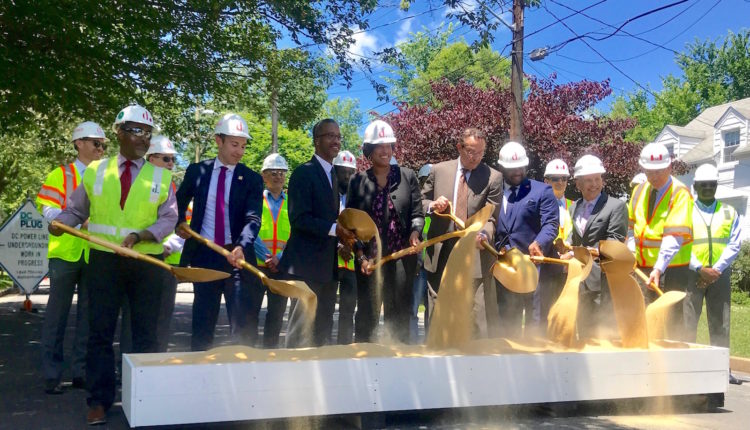
Construction in AU Park kicks off long-planned $500 million initiative to bury vulnerable Pepco feeder lines
Seven years after a derecho downed trees and power lines in DC and the region, Pepco started work this month to bury high-voltage utility lines in the outer neighborhoods of the city — a project envisioned in the aftermath of the powerful storm and the prolonged outages it left behind.
The $500 million, seven-year project, known as DC PLUG, is aimed at preventing service interruptions from weather-related damage by putting key power lines underground. Pepco ratepayers in DC will see a monthly fee of about $1 to $2 for the next 16 years to finance the project, the chair of the DC Public Service Commission, Willie Phillips, said at a groundbreaking ceremony on June 14.

“In order to finance it at a level that is reasonable for all parties, you spread it over time,” Mayor Muriel Bowser added.
The mayor launched the project in American University Park, on Brandywine Street NW, where a road repaving project will intersect with the electrical work in order to minimize disruption — a model that will be followed in other areas.
On streets like Brandywine with major power lines, electric poles carry six high-voltage wires, from which electricity is transmitted to houses through a gray box transformer and cables. Most outages are caused when these high-voltage lines, which carry electricity from nearby substations, are damaged. The DC PLUG project will bury those lines, in addition to placing the transformer boxes on the ground, preventing 95 percent of outages, said Pepco Holdings president and CEO David Velazquez.
The decision to place underground DC’s power lines came in the aftermath of the derecho that left some homes without power for days in June 2012. A task force established by former Mayor Vincent Gray that year recommended the public-private partnership that became DC PLUG, and Mayor Muriel Bowser signed legislation in 2017 enabling the District Department of Transportation (DDOT) and Pepco to work together on the project.
“Most of the damage here was caused by tree limbs and downed trees, poles and power lines — it all ended up in a tangle down in the streets,” said Velazquez, adding that half a million Pepco customers in the region were impacted by the derecho.
The project’s first efforts will underground lines in Ward 3’s AU Park, Tenleytown and Friendship Heights neighborhoods, according to DC PLUG’s schedule by ward, which was established through Public Service Commission proceedings. Unhappy over the allocation of costs between Pepco’s commercial and residential customers, the Apartment and Office Building Association of Metropolitan Washington had challenged the commission’s approval of the DC PLUG plan, but the DC Court of Appeals rejected the appeal in March. Throughout the project, Pepco and DDOT will file a work plan every two years for approval by the commission.
Most electrical lines in more urban parts of the city and downtown — including wards 1, 2 and 6 in their entirety — are already underground, the mayor said.
In total, 30 feeder lines — each feeder affects about 1,000 customers — will be buried, Velazquez said. A schedule from Pepco indicates the next electrical undergrounding project is set to begin in Ward 7 in August. Barnaby Woods, Brookland, Michigan Park, Benning Ridge and Congress Heights are among the neighborhoods in wards 4, 5, 7 and 8 that the project will reach.
On a given block, a project can last for up to a year on a rolling basis with on-and-off construction expected to take about 30 days at a time, said DDOT director Jeff Marootian.
Officials said the project will provide job opportunities for District firms and workers. Velazquez said local contractors receive a preference on bids, with the first contracts for design and management having gone to minority-owned, city-based firms referred to as Certified Business Enterprises.
“Let’s all look forward to celebrating that all of our feeders will be underground in the District of Columbia,” Gray, now the Ward 7 council member, said at Friday’s ceremony.


Comments are closed.